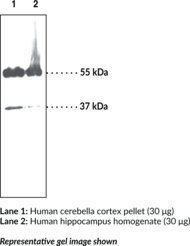Cayman
Showing 28801–28950 of 45550 results
-
Meconin, a noscapine metabolite, is a urinary detection marker for illicit opiate misuse. This product is intended for use as a forensic standard.{20439}
Brand:CaymanSKU:9001140 - 50 mgAvailable on backorder
-
Meconin-d3 contains three deuterium atoms. It is intended for use as an internal standard for the quantification of meconin by GC- or LC-mass spectrometry. Meconin, a noscapine metabolite, is a urinary detection marker for illicit opiate misuse. This product is intended for use as a forensic standard.{20439}
Brand:CaymanSKU:9001141 - 1 mgAvailable on backorder
-
Meconin-d3 contains three deuterium atoms. It is intended for use as an internal standard for the quantification of meconin by GC- or LC-mass spectrometry. Meconin, a noscapine metabolite, is a urinary detection marker for illicit opiate misuse. This product is intended for use as a forensic standard.{20439}
Brand:CaymanSKU:9001141 - 10 mgAvailable on backorder
-
Meconin-d3 contains three deuterium atoms. It is intended for use as an internal standard for the quantification of meconin by GC- or LC-mass spectrometry. Meconin, a noscapine metabolite, is a urinary detection marker for illicit opiate misuse. This product is intended for use as a forensic standard.{20439}
Brand:CaymanSKU:9001141 - 5 mgAvailable on backorder
-
DNA methylation, or the addition of methyl groups to cytosine bases in the dinucleotide CpG, is imperative to proper development and regulates gene expression. The methylation pattern involves the enzymatic processes of methylation and demethylation. A demethylase enzyme has been identified which exhibits demethylase activity associated to a methyl-CpG-binding domain (MBD).{17997} The enzyme is able to revert methylated cytosine bases to cytosines within the particular dinucleotide sequence mdCpdG by catalyzing the cleaving of the methyl group as methanol. MeCP2 and MBD1 (PCM1) repress transcription by binding specifically to methylated DNA.{17999} MBD2 and MBD4 (also known as MED1) colocalize with foci of heavily methylated satellite DNA and mediate the biological functions of the methylation signal. Surprisingly, MBD3 does not bind methylated DNA either in vivo or in vitro. MeCP2, MBD1, MBD2, MBD3, and MBD4 are expressed in somatic tissues, but the expression of MBD1 and MBD2 is reduced or absent in embryonic stem cells, which are known to be deficient in MeCP1 activity. MBD4 has homology to bacterial base excision repair DNA N-glycosylases/lyases.{17996} In some microsatellite unstable tumors MBD4 is mutated at an exonic polynucleotide tract.{17995}
Brand:CaymanSKU:13775 - 1 eaAvailable on backorder
-
Antigen: a mixture of synthetic peptides corresponding two amino acids 268-282 and 337-352 of human MBD4 • Host: rabbit • Cross Reactivity: (+) human MBD4 • Application(s): ICC, IHC, and WB • MeCP2 may function as a mediator of the biological consequences of the methylation signal. It is also reported that this protein functions as a demethylase to activate transcription, as DNA methylation causes gene silencing.
Brand:CaymanSKU:13775- 1 eaAvailable on backorder
-
Antigen: a mixture of synthetic peptides corresponding two amino acids 268-282 and 337-352 of human MBD4 • Host: rabbit • Cross Reactivity: (+) human MBD4 • Application(s): ICC, IHC, and WB • MeCP2 may function as a mediator of the biological consequences of the methylation signal. It is also reported that this protein functions as a demethylase to activate transcription, as DNA methylation causes gene silencing.
Brand:CaymanSKU:13775- 1 ea -
Medetomidine is an imidazole derivative that acts as a selective agonist of α2-adrenoceptors (Ki = 1.08 nM vs. 1750 nM for α1-adrenoceptors).{26978,25422} Medetomidine is a mixture of D and L isomers, with the D form, known as dexmedetomidine (Item No. 15581), described as the active form. Through its effect on α2-adrenoceptors, medetomidine has sedative, antinociceptive, analgesic, and hypothermic actions.{26974,26980} Its effects on pain are additive or synergistic with fentanyl-type opioids.{26977,26976} The effects of medetomidine are effectively countered by α2-adrenoceptor antagonists, like atipamezole.{26979} Selective α2-adrenoceptor agonists, including medetomidine, have anesthetic sparing properties, greatly reducing the dose of anesthetic required following premedication with the α2-adrenoceptor agonist.{26980}
Brand:CaymanSKU:-Out of stock
-
Medetomidine is an imidazole derivative that acts as a selective agonist of α2-adrenoceptors (Ki = 1.08 nM vs. 1750 nM for α1-adrenoceptors).{26978,25422} Medetomidine is a mixture of D and L isomers, with the D form, known as dexmedetomidine (Item No. 15581), described as the active form. Through its effect on α2-adrenoceptors, medetomidine has sedative, antinociceptive, analgesic, and hypothermic actions.{26974,26980} Its effects on pain are additive or synergistic with fentanyl-type opioids.{26977,26976} The effects of medetomidine are effectively countered by α2-adrenoceptor antagonists, like atipamezole.{26979} Selective α2-adrenoceptor agonists, including medetomidine, have anesthetic sparing properties, greatly reducing the dose of anesthetic required following premedication with the α2-adrenoceptor agonist.{26980}
Brand:CaymanSKU:-Out of stock
-
Medetomidine is an imidazole derivative that acts as a selective agonist of α2-adrenoceptors (Ki = 1.08 nM vs. 1750 nM for α1-adrenoceptors).{26978,25422} Medetomidine is a mixture of D and L isomers, with the D form, known as dexmedetomidine (Item No. 15581), described as the active form. Through its effect on α2-adrenoceptors, medetomidine has sedative, antinociceptive, analgesic, and hypothermic actions.{26974,26980} Its effects on pain are additive or synergistic with fentanyl-type opioids.{26977,26976} The effects of medetomidine are effectively countered by α2-adrenoceptor antagonists, like atipamezole.{26979} Selective α2-adrenoceptor agonists, including medetomidine, have anesthetic sparing properties, greatly reducing the dose of anesthetic required following premedication with the α2-adrenoceptor agonist.{26980}
Brand:CaymanSKU:-Out of stock
-
Medetomidine-13C-d3 is intended for use as an internal standard for the quantification of medetomidine by GC- or LC-MS. Medetomidine is an imidazole compound that selectively binds to α2-adrenergic receptors (α2-ARs) over α1-ARs (Kis = 1.08 and 1,800 nM, respectively).{25422}
Brand:CaymanSKU:25041 - 1 mgAvailable on backorder
-
MEDICA 16 is a β,β’-dimethyl hexadecanedioic acid which exhibits hypolipidemic and antidiabetogenic effects in the rat. In animals that were fed a diet which was 0.25% MEDICA 16 by weight, the hypolipidemic effect consisted of a 70-80% decrease in plasma chylomicrons and VLDL-triacylglycerols as well as a 40-60% decrease in plasma VLDL-cholestrol.{3039}
Brand:CaymanSKU:90290 - 1 mgAvailable on backorder
-
MEDICA 16 is a β,β’-dimethyl hexadecanedioic acid which exhibits hypolipidemic and antidiabetogenic effects in the rat. In animals that were fed a diet which was 0.25% MEDICA 16 by weight, the hypolipidemic effect consisted of a 70-80% decrease in plasma chylomicrons and VLDL-triacylglycerols as well as a 40-60% decrease in plasma VLDL-cholestrol.{3039}
Brand:CaymanSKU:90290 - 10 mgAvailable on backorder
-
MEDICA 16 is a β,β’-dimethyl hexadecanedioic acid which exhibits hypolipidemic and antidiabetogenic effects in the rat. In animals that were fed a diet which was 0.25% MEDICA 16 by weight, the hypolipidemic effect consisted of a 70-80% decrease in plasma chylomicrons and VLDL-triacylglycerols as well as a 40-60% decrease in plasma VLDL-cholestrol.{3039}
Brand:CaymanSKU:90290 - 5 mgAvailable on backorder
-
MEDICA 16 is a β,β’-dimethyl hexadecanedioic acid which exhibits hypolipidemic and antidiabetogenic effects in the rat. In animals that were fed a diet which was 0.25% MEDICA 16 by weight, the hypolipidemic effect consisted of a 70-80% decrease in plasma chylomicrons and VLDL-triacylglycerols as well as a 40-60% decrease in plasma VLDL-cholestrol.{3039}
Brand:CaymanSKU:90290 - 50 mgAvailable on backorder
-
Medroxyprogesterone is a progesterone receptor agonist (Ki = 241 nM) and a metabolite of medroxyprogesterone 17-acetate (Item No. 23664).{42538,42539,42540} It induces a conformational change in the C-terminal domain of the progesterone receptor (EC50 = 47.3 nM) and increases alkaline phosphatase activity in T47D breast cancer cells (EC50 = 23 nM).{42538}
Brand:CaymanSKU:24908 - 1 gAvailable on backorder
-
Medroxyprogesterone is a progesterone receptor agonist (Ki = 241 nM) and a metabolite of medroxyprogesterone 17-acetate (Item No. 23664).{42538,42539,42540} It induces a conformational change in the C-terminal domain of the progesterone receptor (EC50 = 47.3 nM) and increases alkaline phosphatase activity in T47D breast cancer cells (EC50 = 23 nM).{42538}
Brand:CaymanSKU:24908 - 100 mgAvailable on backorder
-
Medroxyprogesterone is a progesterone receptor agonist (Ki = 241 nM) and a metabolite of medroxyprogesterone 17-acetate (Item No. 23664).{42538,42539,42540} It induces a conformational change in the C-terminal domain of the progesterone receptor (EC50 = 47.3 nM) and increases alkaline phosphatase activity in T47D breast cancer cells (EC50 = 23 nM).{42538}
Brand:CaymanSKU:24908 - 500 mgAvailable on backorder
-
Medroxyprogesterone 17-acetate is a synthetic progestogen.{37205},{37206},{37207} It prevents fertilization and increases the rate of transport of eggs from the fallopian tubes to the uterus in female ferrets when administered prior to ovulation.{37205} Medroxyprogesterone 17-acetate reversibly blocks ovulation in rats when injected on the last day of diestrus.{37206} It also has anti-androgenic activity in rats, decreasing plasma testosterone (Item Nos. 15645 | ISO60154) levels via induction of hepatic testosterone reductase activity.{37207} Medroxyprogesterone 17-acetate exhibits immunosuppressive effects in vitro and in vivo, inhibiting the production of IFN-γ by CD2/CD3/CD28-stimulated peripheral blood mononuclear cells (PBMCs) at concentrations ≥10 nM and extending the survival of rabbit skin allografts.{37208},{37209} Injectable formulations containing medroxyprogesterone 17-acetate have been used as contraceptives.{37210}
Brand:CaymanSKU:23664 - 1 gAvailable on backorder
-
Medroxyprogesterone 17-acetate is a synthetic progestogen.{37205},{37206},{37207} It prevents fertilization and increases the rate of transport of eggs from the fallopian tubes to the uterus in female ferrets when administered prior to ovulation.{37205} Medroxyprogesterone 17-acetate reversibly blocks ovulation in rats when injected on the last day of diestrus.{37206} It also has anti-androgenic activity in rats, decreasing plasma testosterone (Item Nos. 15645 | ISO60154) levels via induction of hepatic testosterone reductase activity.{37207} Medroxyprogesterone 17-acetate exhibits immunosuppressive effects in vitro and in vivo, inhibiting the production of IFN-γ by CD2/CD3/CD28-stimulated peripheral blood mononuclear cells (PBMCs) at concentrations ≥10 nM and extending the survival of rabbit skin allografts.{37208},{37209} Injectable formulations containing medroxyprogesterone 17-acetate have been used as contraceptives.{37210}
Brand:CaymanSKU:23664 - 500 mgAvailable on backorder
-
Mefenamic acid is a non-steroidal anti-inflammatory drug (NSAID) and a COX-2 inhibitor.{41197} It binds to COX-2 (Kd = 4 nM) and inhibits COX-2-dependent oxygenation of arachidonic acid (Item Nos. 90010 | 90010.1 | 10006607) in vitro (Ki = 10 µM). Mefenamic acid (30 mg/kg) reduces acetic acid-induced writhing in rats.{41198} It inhibits increases in skin thickness in a mouse model of delayed-type hypersensitivity induced by dinitrochlorobenzene (DNBC).{41198} Mefenamic acid also reduces the antibody response to sheep red blood cells in mice.
Brand:CaymanSKU:23650 - 100 mgAvailable on backorder
-
Mefenamic acid is a non-steroidal anti-inflammatory drug (NSAID) and a COX-2 inhibitor.{41197} It binds to COX-2 (Kd = 4 nM) and inhibits COX-2-dependent oxygenation of arachidonic acid (Item Nos. 90010 | 90010.1 | 10006607) in vitro (Ki = 10 µM). Mefenamic acid (30 mg/kg) reduces acetic acid-induced writhing in rats.{41198} It inhibits increases in skin thickness in a mouse model of delayed-type hypersensitivity induced by dinitrochlorobenzene (DNBC).{41198} Mefenamic acid also reduces the antibody response to sheep red blood cells in mice.
Brand:CaymanSKU:23650 - 25 mgAvailable on backorder
-
Mefenamic acid is a non-steroidal anti-inflammatory drug (NSAID) and a COX-2 inhibitor.{41197} It binds to COX-2 (Kd = 4 nM) and inhibits COX-2-dependent oxygenation of arachidonic acid (Item Nos. 90010 | 90010.1 | 10006607) in vitro (Ki = 10 µM). Mefenamic acid (30 mg/kg) reduces acetic acid-induced writhing in rats.{41198} It inhibits increases in skin thickness in a mouse model of delayed-type hypersensitivity induced by dinitrochlorobenzene (DNBC).{41198} Mefenamic acid also reduces the antibody response to sheep red blood cells in mice.
Brand:CaymanSKU:23650 - 50 mgAvailable on backorder
-
Mefenamic acid is a non-steroidal anti-inflammatory drug (NSAID) and a COX-2 inhibitor.{41197} It binds to COX-2 (Kd = 4 nM) and inhibits COX-2-dependent oxygenation of arachidonic acid (Item Nos. 90010 | 90010.1 | 10006607) in vitro (Ki = 10 µM). Mefenamic acid (30 mg/kg) reduces acetic acid-induced writhing in rats.{41198} It inhibits increases in skin thickness in a mouse model of delayed-type hypersensitivity induced by dinitrochlorobenzene (DNBC).{41198} Mefenamic acid also reduces the antibody response to sheep red blood cells in mice.
Brand:CaymanSKU:23650 - 500 mgAvailable on backorder
-
Mefenamic acid-d4 is intended for use as an internal standard for the quantification of mefenamic acid (Item No. 23650) by GC- or LC-MS. Mefenamic acid is a non-steroidal anti-inflammatory drug (NSAID) and a COX-2 inhibitor.{41197} It binds to COX-2 (Kd = 4 nM) and inhibits COX-2-dependent oxygenation of arachidonic acid (Item Nos. 90010 | 90010.1 | 10006607) in vitro (Ki = 10 µM). Mefenamic acid (30 mg/kg) reduces acetic acid-induced writhing in rats.{41198} It inhibits increases in skin thickness in a mouse model of delayed-type hypersensitivity induced by dinitrochlorobenzene (DNBC).{41198} Mefenamic acid also reduces the antibody response to sheep red blood cells in mice.
Brand:CaymanSKU:31788 - 1 mgAvailable on backorder
-
Mefloquine is an orally bioavailable quinolinemethanol derivative with antimalarial properties.{38380} It increases mean survival time and abolishes malarial infection in mice at doses of 10 and 40 mg/kg, respectively. It inhibits hemozoin formation, leading to an increase in free heme in purified trophozoites.{38381} It acts as an antagonist at the adenosine A2A receptor, an agonist at serotonin 5-HT2A and 5-HT2C receptors, and has various effects on calcium homeostasis.{38382,38383} Mefloquine increases the time mice spend in the light side of the light-dark box test and reduces immobility time in the tail suspension test, parameters typically associated with anxiolytic and antidepressant-like behavior.{38383} Formulations containing mefloquine have been used to prevent and treat malaria but have been associated with neuropsychiatric disturbances.
Brand:CaymanSKU:23665 - 100 mgAvailable on backorder
-
Mefloquine is an orally bioavailable quinolinemethanol derivative with antimalarial properties.{38380} It increases mean survival time and abolishes malarial infection in mice at doses of 10 and 40 mg/kg, respectively. It inhibits hemozoin formation, leading to an increase in free heme in purified trophozoites.{38381} It acts as an antagonist at the adenosine A2A receptor, an agonist at serotonin 5-HT2A and 5-HT2C receptors, and has various effects on calcium homeostasis.{38382,38383} Mefloquine increases the time mice spend in the light side of the light-dark box test and reduces immobility time in the tail suspension test, parameters typically associated with anxiolytic and antidepressant-like behavior.{38383} Formulations containing mefloquine have been used to prevent and treat malaria but have been associated with neuropsychiatric disturbances.
Brand:CaymanSKU:23665 - 250 mgAvailable on backorder
-
Mefloquine is an orally bioavailable quinolinemethanol derivative with antimalarial properties.{38380} It increases mean survival time and abolishes malarial infection in mice at doses of 10 and 40 mg/kg, respectively. It inhibits hemozoin formation, leading to an increase in free heme in purified trophozoites.{38381} It acts as an antagonist at the adenosine A2A receptor, an agonist at serotonin 5-HT2A and 5-HT2C receptors, and has various effects on calcium homeostasis.{38382,38383} Mefloquine increases the time mice spend in the light side of the light-dark box test and reduces immobility time in the tail suspension test, parameters typically associated with anxiolytic and antidepressant-like behavior.{38383} Formulations containing mefloquine have been used to prevent and treat malaria but have been associated with neuropsychiatric disturbances.
Brand:CaymanSKU:23665 - 50 mgAvailable on backorder
-
Mefloquine is an orally bioavailable quinolinemethanol derivative with antimalarial properties.{38380} It increases mean survival time and abolishes malarial infection in mice at doses of 10 and 40 mg/kg, respectively. It inhibits hemozoin formation, leading to an increase in free heme in purified trophozoites.{38381} It acts as an antagonist at the adenosine A2A receptor, an agonist at serotonin 5-HT2A and 5-HT2C receptors, and has various effects on calcium homeostasis.{38382,38383} Mefloquine increases the time mice spend in the light side of the light-dark box test and reduces immobility time in the tail suspension test, parameters typically associated with anxiolytic and antidepressant-like behavior.{38383} Formulations containing mefloquine have been used to prevent and treat malaria but have been associated with neuropsychiatric disturbances.
Brand:CaymanSKU:23665 - 500 mgAvailable on backorder
-
MEG is a selective iNOS inhibitor and scavenger of peroxynitrite. The EC50 values for inhibition of iNOS (LPS-treated rat lung), eNOS (bovine endothelial), and nNOS (rat brain) are 11.5, 110, and 60 µM, respectively.{7417} MEG reacts with peroxynitrite with a second order rate constant of 1,900 M−1s−1 at 37°C.{4278} MEG has potent anti-inflammatory activity, which may be due to the combined effect of MEG acting as an inhibitor of iNOS and as a scavenger of peroxynitrite.{5922}
Brand:CaymanSKU:81020 - 10 mgAvailable on backorder
-
MEG is a selective iNOS inhibitor and scavenger of peroxynitrite. The EC50 values for inhibition of iNOS (LPS-treated rat lung), eNOS (bovine endothelial), and nNOS (rat brain) are 11.5, 110, and 60 µM, respectively.{7417} MEG reacts with peroxynitrite with a second order rate constant of 1,900 M−1s−1 at 37°C.{4278} MEG has potent anti-inflammatory activity, which may be due to the combined effect of MEG acting as an inhibitor of iNOS and as a scavenger of peroxynitrite.{5922}
Brand:CaymanSKU:81020 - 100 mgAvailable on backorder
-
MEG is a selective iNOS inhibitor and scavenger of peroxynitrite. The EC50 values for inhibition of iNOS (LPS-treated rat lung), eNOS (bovine endothelial), and nNOS (rat brain) are 11.5, 110, and 60 µM, respectively.{7417} MEG reacts with peroxynitrite with a second order rate constant of 1,900 M−1s−1 at 37°C.{4278} MEG has potent anti-inflammatory activity, which may be due to the combined effect of MEG acting as an inhibitor of iNOS and as a scavenger of peroxynitrite.{5922}
Brand:CaymanSKU:81020 - 5 mgAvailable on backorder
-
MEG is a selective iNOS inhibitor and scavenger of peroxynitrite. The EC50 values for inhibition of iNOS (LPS-treated rat lung), eNOS (bovine endothelial), and nNOS (rat brain) are 11.5, 110, and 60 µM, respectively.{7417} MEG reacts with peroxynitrite with a second order rate constant of 1,900 M−1s−1 at 37°C.{4278} MEG has potent anti-inflammatory activity, which may be due to the combined effect of MEG acting as an inhibitor of iNOS and as a scavenger of peroxynitrite.{5922}
Brand:CaymanSKU:81020 - 50 mgAvailable on backorder
-
MEGA-10 is a nonionic detergent that can be used to solubilize membrane proteins.{48034} It has a critical micelle concentration (CMC) of 4.88 mM under no salt conditions, which decreases in the presence of sodium chloride.{48035} MEGA-10 has been used to reconstitute amino acid transporters from rat liver plasma membrane vesicles into artificial phospholipid membranes.{48036} It has also been used to solubilize the melibiose transport carrier from E. coli membranes and reconstitute it into liposomes.{48037}
Brand:CaymanSKU:25703 - 1 gAvailable on backorder
-
MEGA-10 is a nonionic detergent that can be used to solubilize membrane proteins.{48034} It has a critical micelle concentration (CMC) of 4.88 mM under no salt conditions, which decreases in the presence of sodium chloride.{48035} MEGA-10 has been used to reconstitute amino acid transporters from rat liver plasma membrane vesicles into artificial phospholipid membranes.{48036} It has also been used to solubilize the melibiose transport carrier from E. coli membranes and reconstitute it into liposomes.{48037}
Brand:CaymanSKU:25703 - 5 gAvailable on backorder
-
MEGA-10 is a nonionic detergent that can be used to solubilize membrane proteins.{48034} It has a critical micelle concentration (CMC) of 4.88 mM under no salt conditions, which decreases in the presence of sodium chloride.{48035} MEGA-10 has been used to reconstitute amino acid transporters from rat liver plasma membrane vesicles into artificial phospholipid membranes.{48036} It has also been used to solubilize the melibiose transport carrier from E. coli membranes and reconstitute it into liposomes.{48037}
Brand:CaymanSKU:25703 - 500 mgAvailable on backorder
-
MEGA-8 is a nonionic detergent that can be used to solubilize membrane proteins.{48031} It has a critical micelle concentration (CMC) of 70 mM under no-salt conditions and CMCs ranging from 5 to 64 mM under high and low salt conditions for a variety of salts.{48032}
Brand:CaymanSKU:25701 - 1 gAvailable on backorder
-
MEGA-8 is a nonionic detergent that can be used to solubilize membrane proteins.{48031} It has a critical micelle concentration (CMC) of 70 mM under no-salt conditions and CMCs ranging from 5 to 64 mM under high and low salt conditions for a variety of salts.{48032}
Brand:CaymanSKU:25701 - 10 gAvailable on backorder
-
MEGA-8 is a nonionic detergent that can be used to solubilize membrane proteins.{48031} It has a critical micelle concentration (CMC) of 70 mM under no-salt conditions and CMCs ranging from 5 to 64 mM under high and low salt conditions for a variety of salts.{48032}
Brand:CaymanSKU:25701 - 25 gAvailable on backorder
-
MEGA-8 is a nonionic detergent that can be used to solubilize membrane proteins.{48031} It has a critical micelle concentration (CMC) of 70 mM under no-salt conditions and CMCs ranging from 5 to 64 mM under high and low salt conditions for a variety of salts.{48032}
Brand:CaymanSKU:25701 - 5 gAvailable on backorder
-
MEGA-9 is a nonionic detergent that can be used to solubilize membrane proteins.{48034} It has a critical micelle concentration (CMC) of 20 mM under no-salt conditions and CMCs ranging from 2 to 17.1 mM under high and low salt conditions for a variety of salts.{48032} It has been used to solubilize the melibiose transport carrier from E. coli membranes and reconstitute it into liposomes.{48037}
Brand:CaymanSKU:25702 - 1 gAvailable on backorder
-
MEGA-9 is a nonionic detergent that can be used to solubilize membrane proteins.{48034} It has a critical micelle concentration (CMC) of 20 mM under no-salt conditions and CMCs ranging from 2 to 17.1 mM under high and low salt conditions for a variety of salts.{48032} It has been used to solubilize the melibiose transport carrier from E. coli membranes and reconstitute it into liposomes.{48037}
Brand:CaymanSKU:25702 - 10 gAvailable on backorder
-
MEGA-9 is a nonionic detergent that can be used to solubilize membrane proteins.{48034} It has a critical micelle concentration (CMC) of 20 mM under no-salt conditions and CMCs ranging from 2 to 17.1 mM under high and low salt conditions for a variety of salts.{48032} It has been used to solubilize the melibiose transport carrier from E. coli membranes and reconstitute it into liposomes.{48037}
Brand:CaymanSKU:25702 - 5 gAvailable on backorder
-
MEGA-9 is a nonionic detergent that can be used to solubilize membrane proteins.{48034} It has a critical micelle concentration (CMC) of 20 mM under no-salt conditions and CMCs ranging from 2 to 17.1 mM under high and low salt conditions for a variety of salts.{48032} It has been used to solubilize the melibiose transport carrier from E. coli membranes and reconstitute it into liposomes.{48037}
Brand:CaymanSKU:25702 - 500 mgAvailable on backorder
-
Megestryl acetate is a synthetic progestogen and derivative of progesterone originally developed as a contraceptive.{38302} It binds with high relative affinity to the progesterone (Item No. 15876), androgen, and glucocorticoid receptors in mammary cancer cells.{38303} It increases neuropeptide Y (Item No. 15071) by 90-140% and inhibits calcium channel currents in the rat hypothalamus.{38301,38299} Megestryl acetate decreases cytokine and serotonin production in patient-derived peripheral blood mononuclear cells (PBMCs).{38300} In rats, it increases food and water intake when administered at a dose of 50 mg/kg per day.{38301} Formulations containing megestryl acetate have been used in the treatment of endometriosis, hormone-related cancers, and as an appetite stimulant for cancer patients with anorexia and cachexia.{38304}
Brand:CaymanSKU:21749 -Out of stock
-
Megestryl acetate is a synthetic progestogen and derivative of progesterone originally developed as a contraceptive.{38302} It binds with high relative affinity to the progesterone (Item No. 15876), androgen, and glucocorticoid receptors in mammary cancer cells.{38303} It increases neuropeptide Y (Item No. 15071) by 90-140% and inhibits calcium channel currents in the rat hypothalamus.{38301,38299} Megestryl acetate decreases cytokine and serotonin production in patient-derived peripheral blood mononuclear cells (PBMCs).{38300} In rats, it increases food and water intake when administered at a dose of 50 mg/kg per day.{38301} Formulations containing megestryl acetate have been used in the treatment of endometriosis, hormone-related cancers, and as an appetite stimulant for cancer patients with anorexia and cachexia.{38304}
Brand:CaymanSKU:21749 -Out of stock
-
MEGX is an active metabolite of lidocaine.{42862} It is formed via N-deethylation of lidocaine by the hepatic cytochrome P450 (CYP) isoform CYP3A4. Topical administration of MEGX (2% v/v) reduces thrombus formation in a hamster model of laser-induced microvascular injury.{42863} Plasma levels of MEGX following lidocaine administration have been used to monitor declining liver function in patients with cirrhosis.{42862}
Brand:CaymanSKU:28019 - 1 mgAvailable on backorder
-
MEGX is an active metabolite of lidocaine.{42862} It is formed via N-deethylation of lidocaine by the hepatic cytochrome P450 (CYP) isoform CYP3A4. Topical administration of MEGX (2% v/v) reduces thrombus formation in a hamster model of laser-induced microvascular injury.{42863} Plasma levels of MEGX following lidocaine administration have been used to monitor declining liver function in patients with cirrhosis.{42862}
Brand:CaymanSKU:28019 - 10 mgAvailable on backorder
-
MEGX is an active metabolite of lidocaine.{42862} It is formed via N-deethylation of lidocaine by the hepatic cytochrome P450 (CYP) isoform CYP3A4. Topical administration of MEGX (2% v/v) reduces thrombus formation in a hamster model of laser-induced microvascular injury.{42863} Plasma levels of MEGX following lidocaine administration have been used to monitor declining liver function in patients with cirrhosis.{42862}
Brand:CaymanSKU:28019 - 25 mgAvailable on backorder
-
MEGX is an active metabolite of lidocaine.{42862} It is formed via N-deethylation of lidocaine by the hepatic cytochrome P450 (CYP) isoform CYP3A4. Topical administration of MEGX (2% v/v) reduces thrombus formation in a hamster model of laser-induced microvascular injury.{42863} Plasma levels of MEGX following lidocaine administration have been used to monitor declining liver function in patients with cirrhosis.{42862}
Brand:CaymanSKU:28019 - 5 mgAvailable on backorder
-
Meisoindigo is a derivative of indirubin (Item No. 14155) that has anticancer activity.{41774} It inhibits the growth of NB4, HL-60, and U937 leukemia and primary acute myeloid leukemia (AML) cells when used at concentrations of 5 and 10 µM. It also halts the cell cycle at the G0/G1 phase and induces apoptosis in leukemia cell lines and primary AML cells, induces myeloid differentiation, and potentiates the effects of cytarabine (Item No. 16069) and idarubicin (Item No. 14176). Meisoindigo (10 µM) also induces apoptosis, decreases adherence, and decreases the expression of vascular cell adhesion molecule-1 (VCAM-1) in ECV304 human vein endothelial cells.{41775} Meisoindigo (50-150 mg/kg per day) decreases spleen size in an HL-60 mouse xenograft model of AML in a dose-dependent manner.
Brand:CaymanSKU:-Available on backorder
-
Meisoindigo is a derivative of indirubin (Item No. 14155) that has anticancer activity.{41774} It inhibits the growth of NB4, HL-60, and U937 leukemia and primary acute myeloid leukemia (AML) cells when used at concentrations of 5 and 10 µM. It also halts the cell cycle at the G0/G1 phase and induces apoptosis in leukemia cell lines and primary AML cells, induces myeloid differentiation, and potentiates the effects of cytarabine (Item No. 16069) and idarubicin (Item No. 14176). Meisoindigo (10 µM) also induces apoptosis, decreases adherence, and decreases the expression of vascular cell adhesion molecule-1 (VCAM-1) in ECV304 human vein endothelial cells.{41775} Meisoindigo (50-150 mg/kg per day) decreases spleen size in an HL-60 mouse xenograft model of AML in a dose-dependent manner.
Brand:CaymanSKU:-Available on backorder
-
Meisoindigo is a derivative of indirubin (Item No. 14155) that has anticancer activity.{41774} It inhibits the growth of NB4, HL-60, and U937 leukemia and primary acute myeloid leukemia (AML) cells when used at concentrations of 5 and 10 µM. It also halts the cell cycle at the G0/G1 phase and induces apoptosis in leukemia cell lines and primary AML cells, induces myeloid differentiation, and potentiates the effects of cytarabine (Item No. 16069) and idarubicin (Item No. 14176). Meisoindigo (10 µM) also induces apoptosis, decreases adherence, and decreases the expression of vascular cell adhesion molecule-1 (VCAM-1) in ECV304 human vein endothelial cells.{41775} Meisoindigo (50-150 mg/kg per day) decreases spleen size in an HL-60 mouse xenograft model of AML in a dose-dependent manner.
Brand:CaymanSKU:-Available on backorder
-
Meisoindigo is a derivative of indirubin (Item No. 14155) that has anticancer activity.{41774} It inhibits the growth of NB4, HL-60, and U937 leukemia and primary acute myeloid leukemia (AML) cells when used at concentrations of 5 and 10 µM. It also halts the cell cycle at the G0/G1 phase and induces apoptosis in leukemia cell lines and primary AML cells, induces myeloid differentiation, and potentiates the effects of cytarabine (Item No. 16069) and idarubicin (Item No. 14176). Meisoindigo (10 µM) also induces apoptosis, decreases adherence, and decreases the expression of vascular cell adhesion molecule-1 (VCAM-1) in ECV304 human vein endothelial cells.{41775} Meisoindigo (50-150 mg/kg per day) decreases spleen size in an HL-60 mouse xenograft model of AML in a dose-dependent manner.
Brand:CaymanSKU:-Available on backorder
-
MAP kinase kinase 1 (MAPKK1) is an integral component of the MAP kinase cascade that regulates cell growth and differentiation {14328,14329}. This pathway also plays a key role in synaptic plasticity in the brain {14327}. Activated MEK1 acts as a dual specificity kinase phosphorylating both a threonine and a tyrosine residue on MAP kinase {14331,14332,14543}. Conversely, there also appears to be a feedback phosphorylation of MEK1 by MAP kinase. The sites on MEK1 that are phosphorylated by MAP kinase on Thr292 and Thr386 {14330}.
Brand:CaymanSKU:10009518 - 1 eaAvailable on backorder
-
Antigen: phosphopeptide corresponding to amino acid residues surrounding phospho-Thr292 of human MEK1 • Host: rabbit • Cross Reactivity: (+) human and rat MEK1; expected to react with bovine, canine, chicken, mouse, non-human primates, and Xenopus MEK1 • Application(s): WB • MEK1 is an integral component of the MAPK cascade that regulates cell growth and differentiation. MEK1 is phosphorylated by MAPK on Thr292 and Thr386.
Brand:CaymanSKU:10009518- 1 eaAvailable on backorder
-
Antigen: phosphopeptide corresponding to amino acid residues surrounding phospho-Thr292 of human MEK1 • Host: rabbit • Cross Reactivity: (+) human and rat MEK1; expected to react with bovine, canine, chicken, mouse, non-human primates, and Xenopus MEK1 • Application(s): WB • MEK1 is an integral component of the MAPK cascade that regulates cell growth and differentiation. MEK1 is phosphorylated by MAPK on Thr292 and Thr386.
Brand:CaymanSKU:10009518- 1 ea -
MAP kinase kinase 1 (MEK1) is an integral component of the MAP kinase cascade that regulates cell growth and differentiation {14328,14329}. This pathway also plays a key role in synaptic plasticity in the brain {14327}. Activated MEK1 acts as a dual specificity kinase phosphorylating both a threonine and a tyrosine residue on MAP kinase {14331,14332,14543}. Conversely, there also appears to be a feedback phosphorylation of MEK1 by MAP kinase. The sites on MEK1 that are phosphorylated by MAP kinase are Thr292 and Thr386 {14330}.
Brand:CaymanSKU:10009517 - 1 eaAvailable on backorder
-
Antigen: phosphopeptide corresponding to amino acid residues surrounding phospho-Thr386 of human MEK 1; expected to react with bovine, canine, chicken, mouse, non-human primates, and Xenopus MEK1 • Host: rabbit • Cross Reactivity: (+) rat MEK1 • Application(s): WB • MEK1 is an integral component of the MAPK cascade that regulates cell growth and differentiation. MEK1 is phosphorylated by MAPK on Thr292 and Thr386.
Brand:CaymanSKU:10009517- 1 eaAvailable on backorder
-
Antigen: phosphopeptide corresponding to amino acid residues surrounding phospho-Thr386 of human MEK 1; expected to react with bovine, canine, chicken, mouse, non-human primates, and Xenopus MEK1 • Host: rabbit • Cross Reactivity: (+) rat MEK1 • Application(s): WB • MEK1 is an integral component of the MAPK cascade that regulates cell growth and differentiation. MEK1 is phosphorylated by MAPK on Thr292 and Thr386.
Brand:CaymanSKU:10009517- 1 ea -
MAP kinase kinase 1 (MEK1) is an integral component of the MAP kinase cascade that regulates cell growth and differentiation.{14328,14329} This pathway also plays a key role in synaptic plasticity in the brain.{14327} Activated MEK1 acts as a dual specificity kinase phosphorylating both a threonine and a tyrosine residue on MAP kinase.{14330,14331,14332}
Brand:CaymanSKU:10009178 - 1 eaAvailable on backorder
-
Antigen: phosphopeptide corresponding to amino acid residues surrounding phospho-Ser218,222 of human MEK1/2 • Host: rabbit • Cross Reactivity: (+) NIH 3T3 cells • Application(s): WB • MEK1 is an integral component of the MAPK cascade that regulates cell growth and differentiation.
Brand:CaymanSKU:10009178- 1 eaAvailable on backorder
-
Antigen: phosphopeptide corresponding to amino acid residues surrounding phospho-Ser218,222 of human MEK1/2 • Host: rabbit • Cross Reactivity: (+) NIH 3T3 cells • Application(s): WB • MEK1 is an integral component of the MAPK cascade that regulates cell growth and differentiation.
Brand:CaymanSKU:10009178- 1 ea -
Brand:CaymanSKU:600182 - 10 µl
Available on backorder
-
The Melanocortin-3 receptor (MC3R) helps regulate energy homeostasis and mice lacking MC3R have increased fat mass and reduced lean mass. Therefore, agonists that selectively activate MC3R might have beneficial effects related to weight gain and glucose metabolism. This assay consists of a 96-well plate coated with a transfection complex containing DNA constructs for MC3R and a cAMP response element regulated Secreted Alkaline Phosphatase (SEAP) reporter (MC3R Reverse Transfection Strip Plate). Cells grown on the transfection complex will express MC3R at the cell surface. Binding of agonists to MC3R initiates a signal transduction resulting in expression of SEAP. SEAP activity is measured following addition of luminescence-based alkaline phosphatase substrate provided in the kit.
Brand:CaymanSKU:600180 - 100 testsAvailable on backorder
-
Immunogen: Synthetic peptide from the N-terminal region of mouse protein MC4R • Host: Rabbit • Species Reactivity: (+) Human, mouse, and rat • Applications: IHC (formalin-fixed paraffin-embedded sections) and WB
Brand:CaymanSKU:10006355- 1 eaAvailable on backorder
-
Immunogen: Synthetic peptide from the N-terminal region of mouse protein MC4R • Host: Rabbit • Species Reactivity: (+) Human, mouse, and rat • Applications: IHC (formalin-fixed paraffin-embedded sections) and WB
Brand:CaymanSKU:10006355- 1 ea -
Melanocortins are known to exert a broad array of physiological actions including ‘melanogenesis, steroidogenesis, sexual function and inflammation, as well as appetite regulation and energy homeostasis’.{12351} These actions are mediated (differentially or concurrently) in part by a family of G protein-coupled receptors, the melanocortin receptors 1-5 (MC1R-MC5R). Melanocortin-4 receptor (MC4R) was first cloned in 1993 with transcripts expressed primarily in the brain.{13229} Genetic studies of mice and humans have established a critical role of MC4R in appetite regulation.{3777} Heterozygous mutations in MC4R account for 1-6% of severe cases of human obesity. Thus, MC4R has been a prime target for therapeutic intervention in obesity.{10617} All known mammalian MC4Rs are 332 amino acids in length with an estimated molecular weight of 37 kDa. The protein is heavily glycosylated and appears at multiple positions on SDS-PAGE.{13230} Cayman’s MC4R Polyclonal Antibody mainly detects an unglycosylated protein at 37 kDa and a glycosylated protein at 55 kDa.
Brand:CaymanSKU:10006355 - 1 eaAvailable on backorder
-
The melanocortin-4 receptor (MC4R) has important roles in weight regulation, sexual function, and inflammation. Mice deficient in MC4R have increased lipid deposition associated with elevated adiposity, while mutations in MC4R in humans are associated with early onset or severe obesity. This assay consists of a 96-well plate coated with a transfection complex containing DNA constructs for MC4R and a cAMP response element regulated Secreted Alkaline Phosphatase (SEAP) reporter (MC4R Reverse Transfection Strip Plate). Cells grown on the transfection complex will express MC4R at the cell surface. Binding of agonists to MC4R initiates a signal transduction cascade resulting in expression of SEAP which is secreted into the cell culture media. SEAP activity is measured following addition of a luminescence-based alkaline phosphatase substrate provided in the kit.
Brand:CaymanSKU:600190 - 100 testsAvailable on backorder
-
Melatonin is an indoleamine neurohormone whose levels vary in a daily cycle, thereby allowing the entrainment of the circadian rhythms of several biological functions in animals, plants, and microbes.{22956} Many biological effects of melatonin are transduced through melatonin receptors, including the MT1, MT2, and MT3 subtypes.{22956} Melatonin also acts as a powerful antioxidant that protects lipids, proteins, and DNA against oxidative damage.{12743,4781} Glutathione peroxidase, superoxide dismutases, and catalase are upregulated by melatonin, and melatonin scavenges free radicals as a terminal antioxidant.{12743,4781}
Brand:CaymanSKU:- -
Melatonin is an indoleamine neurohormone whose levels vary in a daily cycle, thereby allowing the entrainment of the circadian rhythms of several biological functions in animals, plants, and microbes.{22956} Many biological effects of melatonin are transduced through melatonin receptors, including the MT1, MT2, and MT3 subtypes.{22956} Melatonin also acts as a powerful antioxidant that protects lipids, proteins, and DNA against oxidative damage.{12743,4781} Glutathione peroxidase, superoxide dismutases, and catalase are upregulated by melatonin, and melatonin scavenges free radicals as a terminal antioxidant.{12743,4781}
Brand:CaymanSKU:- -
Melatonin is an indoleamine neurohormone whose levels vary in a daily cycle, thereby allowing the entrainment of the circadian rhythms of several biological functions in animals, plants, and microbes.{22956} Many biological effects of melatonin are transduced through melatonin receptors, including the MT1, MT2, and MT3 subtypes.{22956} Melatonin also acts as a powerful antioxidant that protects lipids, proteins, and DNA against oxidative damage.{12743,4781} Glutathione peroxidase, superoxide dismutases, and catalase are upregulated by melatonin, and melatonin scavenges free radicals as a terminal antioxidant.{12743,4781}
Brand:CaymanSKU:- -
Melatonin is an indoleamine neurohormone whose levels vary in a daily cycle, thereby allowing the entrainment of the circadian rhythms of several biological functions in animals, plants, and microbes.{22956} Many biological effects of melatonin are transduced through melatonin receptors, including the MT1, MT2, and MT3 subtypes.{22956} Melatonin also acts as a powerful antioxidant that protects lipids, proteins, and DNA against oxidative damage.{12743,4781} Glutathione peroxidase, superoxide dismutases, and catalase are upregulated by melatonin, and melatonin scavenges free radicals as a terminal antioxidant.{12743,4781}
Brand:CaymanSKU:- -
Melatonin-d4 is intended for use as an internal standard for the quantification of melatonin (Item No. 14427) by GC- or LC-MS. Melatonin is an indoleamine neurohormone whose levels vary in a daily cycle, thereby allowing the entrainment of the circadian rhythms of several biological functions in animals, plants, and microbes.{22956} Many biological effects of melatonin are transduced through melatonin receptors, including the MT1, MT2, and MT3 subtypes.{22956} Melatonin also acts as a powerful antioxidant that protects lipids, proteins, and DNA against oxidative damage.{12743,4781} Glutathione peroxidase, superoxide dismutases, and catalase are upregulated by melatonin, and melatonin scavenges free radicals as a terminal antioxidant.{12743,4781}
Brand:CaymanSKU:22291 -Out of stock
-
Melatonin-d4 is intended for use as an internal standard for the quantification of melatonin (Item No. 14427) by GC- or LC-MS. Melatonin is an indoleamine neurohormone whose levels vary in a daily cycle, thereby allowing the entrainment of the circadian rhythms of several biological functions in animals, plants, and microbes.{22956} Many biological effects of melatonin are transduced through melatonin receptors, including the MT1, MT2, and MT3 subtypes.{22956} Melatonin also acts as a powerful antioxidant that protects lipids, proteins, and DNA against oxidative damage.{12743,4781} Glutathione peroxidase, superoxide dismutases, and catalase are upregulated by melatonin, and melatonin scavenges free radicals as a terminal antioxidant.{12743,4781}
Brand:CaymanSKU:22291 -Out of stock
-
Melatonin-d4 is intended for use as an internal standard for the quantification of melatonin (Item No. 14427) by GC- or LC-MS. Melatonin is an indoleamine neurohormone whose levels vary in a daily cycle, thereby allowing the entrainment of the circadian rhythms of several biological functions in animals, plants, and microbes.{22956} Many biological effects of melatonin are transduced through melatonin receptors, including the MT1, MT2, and MT3 subtypes.{22956} Melatonin also acts as a powerful antioxidant that protects lipids, proteins, and DNA against oxidative damage.{12743,4781} Glutathione peroxidase, superoxide dismutases, and catalase are upregulated by melatonin, and melatonin scavenges free radicals as a terminal antioxidant.{12743,4781}
Brand:CaymanSKU:22291 -Out of stock
-
Meleagrin is an antibiotic derived from a deep ocean, penicillin-producing P. chrysogenum.{28881} It is produced as an end product in the roquefortine branched biosynthetic pathway.{28882,28883} Meleagrin has been identified as an inhibitor of the bacterial enoyl-acyl carrier protein reductase (FabI) with IC50 values of 40.1 and 33.2 µM for S. aureus and E. coli FabI, respectively.{28881} It inhibits the growth of S. aureus, E. coli, and S. pneumoniae with MICs ranging from 32-64 µg/ml.{28881}
Brand:CaymanSKU:-Available on backorder
-
Meleagrin is an antibiotic derived from a deep ocean, penicillin-producing P. chrysogenum.{28881} It is produced as an end product in the roquefortine branched biosynthetic pathway.{28882,28883} Meleagrin has been identified as an inhibitor of the bacterial enoyl-acyl carrier protein reductase (FabI) with IC50 values of 40.1 and 33.2 µM for S. aureus and E. coli FabI, respectively.{28881} It inhibits the growth of S. aureus, E. coli, and S. pneumoniae with MICs ranging from 32-64 µg/ml.{28881}
Brand:CaymanSKU:-Available on backorder
-
Melittin is a small protein that is the principal cytotoxic component of venom of the honey bee, A. mellifera.{29574} Structurally, melittin consists of two α-helical segments forming a bent rod, with hydrophilic residues on the convex side and hydrophobic sites on the concave side.{29574,29572} This allows melittin molecules to assemble as tetramers on membrane surfaces and form pores, resulting in cell death. Bee venom is also known to stimulate phospholipase A2 (PLA2) activity, and this may be linked to melittin-mediated pore production as well as the presence of low molecular weight PLA2 enzymes in the venom.{29572,29573} Melittin also has antimicrobial properties, which, combined with its cytolytic properties, extends its potential for therapeutic applications.{29573}
Brand:CaymanSKU:-Available on backorder
-
Melittin is a small protein that is the principal cytotoxic component of venom of the honey bee, A. mellifera.{29574} Structurally, melittin consists of two α-helical segments forming a bent rod, with hydrophilic residues on the convex side and hydrophobic sites on the concave side.{29574,29572} This allows melittin molecules to assemble as tetramers on membrane surfaces and form pores, resulting in cell death. Bee venom is also known to stimulate phospholipase A2 (PLA2) activity, and this may be linked to melittin-mediated pore production as well as the presence of low molecular weight PLA2 enzymes in the venom.{29572,29573} Melittin also has antimicrobial properties, which, combined with its cytolytic properties, extends its potential for therapeutic applications.{29573}
Brand:CaymanSKU:-Available on backorder
-
Melittin is a small protein that is the principal cytotoxic component of venom of the honey bee, A. mellifera.{29574} Structurally, melittin consists of two α-helical segments forming a bent rod, with hydrophilic residues on the convex side and hydrophobic sites on the concave side.{29574,29572} This allows melittin molecules to assemble as tetramers on membrane surfaces and form pores, resulting in cell death. Bee venom is also known to stimulate phospholipase A2 (PLA2) activity, and this may be linked to melittin-mediated pore production as well as the presence of low molecular weight PLA2 enzymes in the venom.{29572,29573} Melittin also has antimicrobial properties, which, combined with its cytolytic properties, extends its potential for therapeutic applications.{29573}
Brand:CaymanSKU:-Available on backorder
-
Melittoside is an iridoid glycoside that has been found in S. trojana and has antioxidant and enzyme inhibitory activities.{48642,48643} It scavenges free radicals in a Trolox equivalent antioxidant capacity (TEAC) assay.{48642} Melittoside also inhibits the activity of acetylcholinesterase (AChE) and butyrylcholinesterase (BChE) by 24.6 and 12.8%, respectively, when used at a concentration of 250 µg/ml in a cell-free assay.{48643}
Brand:CaymanSKU:29035 - 1 mgAvailable on backorder
-
Melittoside is an iridoid glycoside that has been found in S. trojana and has antioxidant and enzyme inhibitory activities.{48642,48643} It scavenges free radicals in a Trolox equivalent antioxidant capacity (TEAC) assay.{48642} Melittoside also inhibits the activity of acetylcholinesterase (AChE) and butyrylcholinesterase (BChE) by 24.6 and 12.8%, respectively, when used at a concentration of 250 µg/ml in a cell-free assay.{48643}
Brand:CaymanSKU:29035 - 10 mgAvailable on backorder
-
Melittoside is an iridoid glycoside that has been found in S. trojana and has antioxidant and enzyme inhibitory activities.{48642,48643} It scavenges free radicals in a Trolox equivalent antioxidant capacity (TEAC) assay.{48642} Melittoside also inhibits the activity of acetylcholinesterase (AChE) and butyrylcholinesterase (BChE) by 24.6 and 12.8%, respectively, when used at a concentration of 250 µg/ml in a cell-free assay.{48643}
Brand:CaymanSKU:29035 - 25 mgAvailable on backorder
-
Melittoside is an iridoid glycoside that has been found in S. trojana and has antioxidant and enzyme inhibitory activities.{48642,48643} It scavenges free radicals in a Trolox equivalent antioxidant capacity (TEAC) assay.{48642} Melittoside also inhibits the activity of acetylcholinesterase (AChE) and butyrylcholinesterase (BChE) by 24.6 and 12.8%, respectively, when used at a concentration of 250 µg/ml in a cell-free assay.{48643}
Brand:CaymanSKU:29035 - 5 mgAvailable on backorder
-
Meloxicam is a selective inhibitor of COX-2 (IC50s = 11.8 and 143 μM for COX-2 and COX-1, respectively, in an enzyme activity assay) and a non-steroidal anti-inflammatory drug (NSAID).{5788} Meloxicam (0.03%) reduces croton oil-induced increases in TNF-α and IL-1β mRNA levels and increases IL-10 mRNA levels in cornea in a rabbit model of acute ocular inflammation.{15890} It inhibits pleural plasma exudation in a carrageenan-induced rat model of pleurisy when administered at a dose of 3 mg/kg.{5788} In a canine model of unilateral osteoarthritis of the right stifle joint, meloxicam reduces prostaglandin E2 (PGE2) levels in plasma and right stifle joint synovial fluid when administered at a dose of 0.2 mg/kg.{13042} Formulations containing meloxicam have been used in the treatment of osteoarthritis and rheumatoid arthritis.
Brand:CaymanSKU:- -
Meloxicam is a selective inhibitor of COX-2 (IC50s = 11.8 and 143 μM for COX-2 and COX-1, respectively, in an enzyme activity assay) and a non-steroidal anti-inflammatory drug (NSAID).{5788} Meloxicam (0.03%) reduces croton oil-induced increases in TNF-α and IL-1β mRNA levels and increases IL-10 mRNA levels in cornea in a rabbit model of acute ocular inflammation.{15890} It inhibits pleural plasma exudation in a carrageenan-induced rat model of pleurisy when administered at a dose of 3 mg/kg.{5788} In a canine model of unilateral osteoarthritis of the right stifle joint, meloxicam reduces prostaglandin E2 (PGE2) levels in plasma and right stifle joint synovial fluid when administered at a dose of 0.2 mg/kg.{13042} Formulations containing meloxicam have been used in the treatment of osteoarthritis and rheumatoid arthritis.
Brand:CaymanSKU:- -
Meloxicam is a selective inhibitor of COX-2 (IC50s = 11.8 and 143 μM for COX-2 and COX-1, respectively, in an enzyme activity assay) and a non-steroidal anti-inflammatory drug (NSAID).{5788} Meloxicam (0.03%) reduces croton oil-induced increases in TNF-α and IL-1β mRNA levels and increases IL-10 mRNA levels in cornea in a rabbit model of acute ocular inflammation.{15890} It inhibits pleural plasma exudation in a carrageenan-induced rat model of pleurisy when administered at a dose of 3 mg/kg.{5788} In a canine model of unilateral osteoarthritis of the right stifle joint, meloxicam reduces prostaglandin E2 (PGE2) levels in plasma and right stifle joint synovial fluid when administered at a dose of 0.2 mg/kg.{13042} Formulations containing meloxicam have been used in the treatment of osteoarthritis and rheumatoid arthritis.
Brand:CaymanSKU:- -
Meloxicam is a selective inhibitor of COX-2 (IC50s = 11.8 and 143 μM for COX-2 and COX-1, respectively, in an enzyme activity assay) and a non-steroidal anti-inflammatory drug (NSAID).{5788} Meloxicam (0.03%) reduces croton oil-induced increases in TNF-α and IL-1β mRNA levels and increases IL-10 mRNA levels in cornea in a rabbit model of acute ocular inflammation.{15890} It inhibits pleural plasma exudation in a carrageenan-induced rat model of pleurisy when administered at a dose of 3 mg/kg.{5788} In a canine model of unilateral osteoarthritis of the right stifle joint, meloxicam reduces prostaglandin E2 (PGE2) levels in plasma and right stifle joint synovial fluid when administered at a dose of 0.2 mg/kg.{13042} Formulations containing meloxicam have been used in the treatment of osteoarthritis and rheumatoid arthritis.
Brand:CaymanSKU:- -
Meloxicam-d3 is intended for use as an internal standard for the quantification of meloxicam (Item No. 14906) by GC- or LC-MS. Meloxicam is a selective inhibitor of COX-2 (IC50s = 11.8 and 143 μM for COX-2 and COX-1, respectively, in an enzyme activity assay) and a non-steroidal anti-inflammatory drug (NSAID).{5788} Meloxicam (0.03%) reduces croton oil-induced increases in TNF-α and IL-1β mRNA levels and increases IL-10 mRNA levels in cornea in a rabbit model of acute ocular inflammation.{15890} It inhibits pleural plasma exudation in a carrageenan-induced rat model of pleurisy when administered at a dose of 3 mg/kg.{5788} In a canine model of unilateral osteoarthritis of the right stifle joint, meloxicam reduces prostaglandin E2 (PGE2) levels in plasma and right stifle joint synovial fluid when administered at a dose of 0.2 mg/kg.{13042} Formulations containing meloxicam have been used in the treatment of osteoarthritis and rheumatoid arthritis.
Brand:CaymanSKU:25508 - 1 mgAvailable on backorder
-
Meloxicam-d3 is intended for use as an internal standard for the quantification of meloxicam (Item No. 14906) by GC- or LC-MS. Meloxicam is a selective inhibitor of COX-2 (IC50s = 11.8 and 143 μM for COX-2 and COX-1, respectively, in an enzyme activity assay) and a non-steroidal anti-inflammatory drug (NSAID).{5788} Meloxicam (0.03%) reduces croton oil-induced increases in TNF-α and IL-1β mRNA levels and increases IL-10 mRNA levels in cornea in a rabbit model of acute ocular inflammation.{15890} It inhibits pleural plasma exudation in a carrageenan-induced rat model of pleurisy when administered at a dose of 3 mg/kg.{5788} In a canine model of unilateral osteoarthritis of the right stifle joint, meloxicam reduces prostaglandin E2 (PGE2) levels in plasma and right stifle joint synovial fluid when administered at a dose of 0.2 mg/kg.{13042} Formulations containing meloxicam have been used in the treatment of osteoarthritis and rheumatoid arthritis.
Brand:CaymanSKU:25508 - 500 µgAvailable on backorder
-
Melperone is an atypical antipsychotic.{25511} It binds to α1- and α2-adrenergic and dopamine D2 receptors (Kds = 180, 150, and 180 nM, respectively), as well as the serotonin (5-HT) receptor subtype 5-HT2A (Kd = 102 nM). It is selective for these receptors over histamine H1, muscarinic, 5-HT1A, 5-HT1D, and 5-HT2C receptors (Kds = 580, >10,000, 2,200, 3,400, and 2,100 nM, respectively). Melperone (2 mg/kg per day) increases basal, but not amphetamine-induced, extracellular dopamine levels in the rat nucleus accumbens.{53986}
Brand:CaymanSKU:19770 -Available on backorder
-
Melperone is an atypical antipsychotic.{25511} It binds to α1- and α2-adrenergic and dopamine D2 receptors (Kds = 180, 150, and 180 nM, respectively), as well as the serotonin (5-HT) receptor subtype 5-HT2A (Kd = 102 nM). It is selective for these receptors over histamine H1, muscarinic, 5-HT1A, 5-HT1D, and 5-HT2C receptors (Kds = 580, >10,000, 2,200, 3,400, and 2,100 nM, respectively). Melperone (2 mg/kg per day) increases basal, but not amphetamine-induced, extracellular dopamine levels in the rat nucleus accumbens.{53986}
Brand:CaymanSKU:19770 -Available on backorder
-
Melperone is an atypical antipsychotic.{25511} It binds to α1- and α2-adrenergic and dopamine D2 receptors (Kds = 180, 150, and 180 nM, respectively), as well as the serotonin (5-HT) receptor subtype 5-HT2A (Kd = 102 nM). It is selective for these receptors over histamine H1, muscarinic, 5-HT1A, 5-HT1D, and 5-HT2C receptors (Kds = 580, >10,000, 2,200, 3,400, and 2,100 nM, respectively). Melperone (2 mg/kg per day) increases basal, but not amphetamine-induced, extracellular dopamine levels in the rat nucleus accumbens.{53986}
Brand:CaymanSKU:19770 -Available on backorder
-
Melperone is an atypical antipsychotic.{25511} It binds to α1- and α2-adrenergic and dopamine D2 receptors (Kds = 180, 150, and 180 nM, respectively), as well as the serotonin (5-HT) receptor subtype 5-HT2A (Kd = 102 nM). It is selective for these receptors over histamine H1, muscarinic, 5-HT1A, 5-HT1D, and 5-HT2C receptors (Kds = 580, >10,000, 2,200, 3,400, and 2,100 nM, respectively). Melperone (2 mg/kg per day) increases basal, but not amphetamine-induced, extracellular dopamine levels in the rat nucleus accumbens.{53986}
Brand:CaymanSKU:19770 -Available on backorder
-
Melperone-d4 is intended for use as an internal standard for the quantification of melperone (Item No. 19770) by GC- or LC-MS. Melperone is an atypical antipsychotic.{25511} It binds to α1- and α2-adrenergic and dopamine D2 receptors (Kds = 180, 150, and 180 nM, respectively), as well as the serotonin (5-HT) receptor subtype 5-HT2A (Kd = 102 nM). It is selective for these receptors over histamine H1, muscarinic, 5-HT1A, 5-HT1D, and 5-HT2C receptors (Kds = 580, >10,000, 2,200, 3,400, and 2,100 nM, respectively). Melperone (2 mg/kg per day) increases basal, but not amphetamine-induced, extracellular dopamine levels in the rat nucleus accumbens.{53986}
Brand:CaymanSKU:31489 - 1 mgAvailable on backorder
-
Melperone-d4 is intended for use as an internal standard for the quantification of melperone (Item No. 19770) by GC- or LC-MS. Melperone is an atypical antipsychotic.{25511} It binds to α1- and α2-adrenergic and dopamine D2 receptors (Kds = 180, 150, and 180 nM, respectively), as well as the serotonin (5-HT) receptor subtype 5-HT2A (Kd = 102 nM). It is selective for these receptors over histamine H1, muscarinic, 5-HT1A, 5-HT1D, and 5-HT2C receptors (Kds = 580, >10,000, 2,200, 3,400, and 2,100 nM, respectively). Melperone (2 mg/kg per day) increases basal, but not amphetamine-induced, extracellular dopamine levels in the rat nucleus accumbens.{53986}
Brand:CaymanSKU:31489 - 5 mgAvailable on backorder
-
Melperone-d4 is intended for use as an internal standard for the quantification of melperone (Item No. 19770) by GC- or LC-MS. Melperone is an atypical antipsychotic.{25511} It binds to α1- and α2-adrenergic and dopamine D2 receptors (Kds = 180, 150, and 180 nM, respectively), as well as the serotonin (5-HT) receptor subtype 5-HT2A (Kd = 102 nM). It is selective for these receptors over histamine H1, muscarinic, 5-HT1A, 5-HT1D, and 5-HT2C receptors (Kds = 580, >10,000, 2,200, 3,400, and 2,100 nM, respectively). Melperone (2 mg/kg per day) increases basal, but not amphetamine-induced, extracellular dopamine levels in the rat nucleus accumbens.{53986}
Brand:CaymanSKU:31489 - 500 µgAvailable on backorder
-
Melphalan is a phenylalanine derivative of mechlorethamine, belonging to the family of nitrogen mustard alkylating agents that are used for chemotherapy.{26270} It attaches an alkyl group to guanine bases in DNA at the 7-nitrogen of the imidazole ring, which leads to DNA interstrand and intrastrand crosslinks, cytotoxicity, and apoptosis.{26270} Melphalan can inhibit the growth of PC-3 prostate cancer cells with IC50 values of 0.074 or 0.77 μM for sequential dosing or single dosing, respectively.{27295}
Brand:CaymanSKU:-Out of stock
-
Melphalan is a phenylalanine derivative of mechlorethamine, belonging to the family of nitrogen mustard alkylating agents that are used for chemotherapy.{26270} It attaches an alkyl group to guanine bases in DNA at the 7-nitrogen of the imidazole ring, which leads to DNA interstrand and intrastrand crosslinks, cytotoxicity, and apoptosis.{26270} Melphalan can inhibit the growth of PC-3 prostate cancer cells with IC50 values of 0.074 or 0.77 μM for sequential dosing or single dosing, respectively.{27295}
Brand:CaymanSKU:-Out of stock
-
Melphalan is a phenylalanine derivative of mechlorethamine, belonging to the family of nitrogen mustard alkylating agents that are used for chemotherapy.{26270} It attaches an alkyl group to guanine bases in DNA at the 7-nitrogen of the imidazole ring, which leads to DNA interstrand and intrastrand crosslinks, cytotoxicity, and apoptosis.{26270} Melphalan can inhibit the growth of PC-3 prostate cancer cells with IC50 values of 0.074 or 0.77 μM for sequential dosing or single dosing, respectively.{27295}
Brand:CaymanSKU:-Out of stock
-
Melphalan is a phenylalanine derivative of mechlorethamine, belonging to the family of nitrogen mustard alkylating agents that are used for chemotherapy.{26270} It attaches an alkyl group to guanine bases in DNA at the 7-nitrogen of the imidazole ring, which leads to DNA interstrand and intrastrand crosslinks, cytotoxicity, and apoptosis.{26270} Melphalan can inhibit the growth of PC-3 prostate cancer cells with IC50 values of 0.074 or 0.77 μM for sequential dosing or single dosing, respectively.{27295}
Brand:CaymanSKU:-Out of stock
-
Memantine is an NMDA receptor antagonist that blocks NMDA-induced currents in rat retinal ganglion cells by 90% when used at a concentration of 12 μM.{22399} It reverses inhibition of dephosphorylation of the synthetic tau phosphopeptide p17 (tau194-207) induced by the endogenous inhibitor of protein phosphatase 2A (PP2A) I1PP2A in vitro.{41954} In vivo, memantine (2 mg/kg) restores PP2A activity, decreases GSK-3β and amyloid-β (Aβ) levels in the hippocampus, cerebral cortex, and ventricular areas, and attenuates spatial learning and memory in the AAV1-I1PP2A rat model of Alzheimer’s disease. Memantine (20 mg/kg) reduces responding on the ethanol-associated lever in a cue-induced ethanol-seeking test in rats.{41955} It also decreases secretion of matrix metalloproteinase-9 (MMP-9), degradation of collagen IV, the size of cerebral ischemia-induced brain infarcts, and neuronal cell death in a mouse model of focal cerebral ischemia.{41956}
Brand:CaymanSKU:- -
Memantine is an NMDA receptor antagonist that blocks NMDA-induced currents in rat retinal ganglion cells by 90% when used at a concentration of 12 μM.{22399} It reverses inhibition of dephosphorylation of the synthetic tau phosphopeptide p17 (tau194-207) induced by the endogenous inhibitor of protein phosphatase 2A (PP2A) I1PP2A in vitro.{41954} In vivo, memantine (2 mg/kg) restores PP2A activity, decreases GSK-3β and amyloid-β (Aβ) levels in the hippocampus, cerebral cortex, and ventricular areas, and attenuates spatial learning and memory in the AAV1-I1PP2A rat model of Alzheimer’s disease. Memantine (20 mg/kg) reduces responding on the ethanol-associated lever in a cue-induced ethanol-seeking test in rats.{41955} It also decreases secretion of matrix metalloproteinase-9 (MMP-9), degradation of collagen IV, the size of cerebral ischemia-induced brain infarcts, and neuronal cell death in a mouse model of focal cerebral ischemia.{41956}
Brand:CaymanSKU:- -
Memantine is an NMDA receptor antagonist that blocks NMDA-induced currents in rat retinal ganglion cells by 90% when used at a concentration of 12 μM.{22399} It reverses inhibition of dephosphorylation of the synthetic tau phosphopeptide p17 (tau194-207) induced by the endogenous inhibitor of protein phosphatase 2A (PP2A) I1PP2A in vitro.{41954} In vivo, memantine (2 mg/kg) restores PP2A activity, decreases GSK-3β and amyloid-β (Aβ) levels in the hippocampus, cerebral cortex, and ventricular areas, and attenuates spatial learning and memory in the AAV1-I1PP2A rat model of Alzheimer’s disease. Memantine (20 mg/kg) reduces responding on the ethanol-associated lever in a cue-induced ethanol-seeking test in rats.{41955} It also decreases secretion of matrix metalloproteinase-9 (MMP-9), degradation of collagen IV, the size of cerebral ischemia-induced brain infarcts, and neuronal cell death in a mouse model of focal cerebral ischemia.{41956}
Brand:CaymanSKU:- -
Memantine is an NMDA receptor antagonist that blocks NMDA-induced currents in rat retinal ganglion cells by 90% when used at a concentration of 12 μM.{22399} It reverses inhibition of dephosphorylation of the synthetic tau phosphopeptide p17 (tau194-207) induced by the endogenous inhibitor of protein phosphatase 2A (PP2A) I1PP2A in vitro.{41954} In vivo, memantine (2 mg/kg) restores PP2A activity, decreases GSK-3β and amyloid-β (Aβ) levels in the hippocampus, cerebral cortex, and ventricular areas, and attenuates spatial learning and memory in the AAV1-I1PP2A rat model of Alzheimer’s disease. Memantine (20 mg/kg) reduces responding on the ethanol-associated lever in a cue-induced ethanol-seeking test in rats.{41955} It also decreases secretion of matrix metalloproteinase-9 (MMP-9), degradation of collagen IV, the size of cerebral ischemia-induced brain infarcts, and neuronal cell death in a mouse model of focal cerebral ischemia.{41956}
Brand:CaymanSKU:- -
Memantine lactose adduct is a lactose adduct of memantine (Item No. 14184) and an intermediate in the synthesis of adamantane amine antibiotics.{38737}
Brand:CaymanSKU:20662 -Available on backorder
-
Memantine lactose adduct is a lactose adduct of memantine (Item No. 14184) and an intermediate in the synthesis of adamantane amine antibiotics.{38737}
Brand:CaymanSKU:20662 -Available on backorder
-
Memantine lactose adduct is a lactose adduct of memantine (Item No. 14184) and an intermediate in the synthesis of adamantane amine antibiotics.{38737}
Brand:CaymanSKU:20662 -Available on backorder
-
Memantine-d6 is intended for use as an internal standard for the quantification of memantine (Item No. 14184) by GC- or LC-MS. Memantine is an NMDA receptor antagonist that blocks NMDA-induced currents in rat retinal ganglion cells by 90% when used at a concentration of 12 μM.{22399} It reverses inhibition of dephosphorylation of the synthetic tau phosphopeptide p17 (tau194-207) induced by the endogenous inhibitor of protein phosphatase 2A (PP2A) I1PP2A in vitro.{41954} In vivo, memantine (2 mg/kg) restores PP2A activity, decreases GSK-3β and amyloid-β (Aβ) levels in the hippocampus, cerebral cortex, and ventricular areas, and attenuates spatial learning and memory deficits in the AAV1-I1PP2A rat model of Alzheimer’s disease. Memantine (20 mg/kg) reduces responding on the ethanol-associated lever in a cue-induced ethanol-seeking test in rats.{41955} It also decreases secretion of matrix metalloproteinase-9 (MMP-9), degradation of collagen IV, the size of cerebral ischemia-induced brain infarcts, and neuronal cell death in a mouse model of focal cerebral ischemia.{41956}
Brand:CaymanSKU:25463 - 1 mgAvailable on backorder
-
Memantine-d6 is intended for use as an internal standard for the quantification of memantine (Item No. 14184) by GC- or LC-MS. Memantine is an NMDA receptor antagonist that blocks NMDA-induced currents in rat retinal ganglion cells by 90% when used at a concentration of 12 μM.{22399} It reverses inhibition of dephosphorylation of the synthetic tau phosphopeptide p17 (tau194-207) induced by the endogenous inhibitor of protein phosphatase 2A (PP2A) I1PP2A in vitro.{41954} In vivo, memantine (2 mg/kg) restores PP2A activity, decreases GSK-3β and amyloid-β (Aβ) levels in the hippocampus, cerebral cortex, and ventricular areas, and attenuates spatial learning and memory deficits in the AAV1-I1PP2A rat model of Alzheimer’s disease. Memantine (20 mg/kg) reduces responding on the ethanol-associated lever in a cue-induced ethanol-seeking test in rats.{41955} It also decreases secretion of matrix metalloproteinase-9 (MMP-9), degradation of collagen IV, the size of cerebral ischemia-induced brain infarcts, and neuronal cell death in a mouse model of focal cerebral ischemia.{41956}
Brand:CaymanSKU:25463 - 500 µgAvailable on backorder
-
MEN10376 is a peptide neurokinin-2 (NK2) receptor antagonist.{41380} It inhibits contractions induced by neurokinin A (NKA) in endothelium-deprived isolated rabbit pulmonary artery (pA2 = 8.08), which is endogenously enriched in NK2 receptors. It is selective for NK2 receptors in isolated rabbit pulmonary artery over NK2 receptors in isolated hamster trachea (pA2 = 5.64 using NKA as an agonist) and NK1 receptors in isolated guinea pig ileum (pA2 = 5.66 using substance P methyl ester as an agonist), tissues that highly express these respective receptors, as well as NK3 receptors in isolated guinea pig cerebral cortex membranes (Ki = >10 μM). In vivo, MEN10376 (1 and 3 μmol/kg) inhibits increases in bladder motility induced by the NK2 receptor agonist [β-Ala8]-NKA(4-10) in anesthetized rats, as well as [β-Ala8]-NKA(4-10)-induced increases in bronchoconstriction in anesthetized guinea pigs.
Brand:CaymanSKU:31142 - 1 mgAvailable on backorder
-
MEN10376 is a peptide neurokinin-2 (NK2) receptor antagonist.{41380} It inhibits contractions induced by neurokinin A (NKA) in endothelium-deprived isolated rabbit pulmonary artery (pA2 = 8.08), which is endogenously enriched in NK2 receptors. It is selective for NK2 receptors in isolated rabbit pulmonary artery over NK2 receptors in isolated hamster trachea (pA2 = 5.64 using NKA as an agonist) and NK1 receptors in isolated guinea pig ileum (pA2 = 5.66 using substance P methyl ester as an agonist), tissues that highly express these respective receptors, as well as NK3 receptors in isolated guinea pig cerebral cortex membranes (Ki = >10 μM). In vivo, MEN10376 (1 and 3 μmol/kg) inhibits increases in bladder motility induced by the NK2 receptor agonist [β-Ala8]-NKA(4-10) in anesthetized rats, as well as [β-Ala8]-NKA(4-10)-induced increases in bronchoconstriction in anesthetized guinea pigs.
Brand:CaymanSKU:31142 - 5 mgAvailable on backorder
-
MEN10376 is a peptide neurokinin-2 (NK2) receptor antagonist.{41380} It inhibits contractions induced by neurokinin A (NKA) in endothelium-deprived isolated rabbit pulmonary artery (pA2 = 8.08), which is endogenously enriched in NK2 receptors. It is selective for NK2 receptors in isolated rabbit pulmonary artery over NK2 receptors in isolated hamster trachea (pA2 = 5.64 using NKA as an agonist) and NK1 receptors in isolated guinea pig ileum (pA2 = 5.66 using substance P methyl ester as an agonist), tissues that highly express these respective receptors, as well as NK3 receptors in isolated guinea pig cerebral cortex membranes (Ki = >10 μM). In vivo, MEN10376 (1 and 3 μmol/kg) inhibits increases in bladder motility induced by the NK2 receptor agonist [β-Ala8]-NKA(4-10) in anesthetized rats, as well as [β-Ala8]-NKA(4-10)-induced increases in bronchoconstriction in anesthetized guinea pigs.
Brand:CaymanSKU:31142 - 500 µgAvailable on backorder
-
Menaquinone 4 (MK-4) is the predominant homolog of vitamin K2 and is composed of a naphthoquinone base with four isoprenoid units in the side chain.{29936} It is formed primarily via conversion of vitamin K1 (Item No. 21051) in vivo and accumulates in various tissues, including the brain.{37777,37778} MK-4 halts the cell cycle at the G phase in HepG2, Hep3B, and Huh7 hepatocellular carcinoma cells in a concentration-dependent manner.{37779} It also inhibits IκB kinase (IKK) activity, IκBα phosphorylation, and the transcriptional activity of NF-κB. Vitamin K2 may have a role in bone metabolism.{29936}
Brand:CaymanSKU:-Available on backorder
-
Menaquinone 4 (MK-4) is the predominant homolog of vitamin K2 and is composed of a naphthoquinone base with four isoprenoid units in the side chain.{29936} It is formed primarily via conversion of vitamin K1 (Item No. 21051) in vivo and accumulates in various tissues, including the brain.{37777,37778} MK-4 halts the cell cycle at the G phase in HepG2, Hep3B, and Huh7 hepatocellular carcinoma cells in a concentration-dependent manner.{37779} It also inhibits IκB kinase (IKK) activity, IκBα phosphorylation, and the transcriptional activity of NF-κB. Vitamin K2 may have a role in bone metabolism.{29936}
Brand:CaymanSKU:-Available on backorder
-
Menaquinone 4 (MK-4) is the predominant homolog of vitamin K2 and is composed of a naphthoquinone base with four isoprenoid units in the side chain.{29936} It is formed primarily via conversion of vitamin K1 (Item No. 21051) in vivo and accumulates in various tissues, including the brain.{37777,37778} MK-4 halts the cell cycle at the G phase in HepG2, Hep3B, and Huh7 hepatocellular carcinoma cells in a concentration-dependent manner.{37779} It also inhibits IκB kinase (IKK) activity, IκBα phosphorylation, and the transcriptional activity of NF-κB. Vitamin K2 may have a role in bone metabolism.{29936}
Brand:CaymanSKU:-Available on backorder
-
Menaquinone 4 (MK-4) is the predominant homolog of vitamin K2 and is composed of a naphthoquinone base with four isoprenoid units in the side chain.{29936} It is formed primarily via conversion of vitamin K1 (Item No. 21051) in vivo and accumulates in various tissues, including the brain.{37777,37778} MK-4 halts the cell cycle at the G phase in HepG2, Hep3B, and Huh7 hepatocellular carcinoma cells in a concentration-dependent manner.{37779} It also inhibits IκB kinase (IKK) activity, IκBα phosphorylation, and the transcriptional activity of NF-κB. Vitamin K2 may have a role in bone metabolism.{29936}
Brand:CaymanSKU:-Available on backorder
-
Menaquinone 4-d7 (MK-4-d7) is intended for use as an internal standard for the quantification of MK-4 (Item No. 18423) by GC- or LC-MS. MK-4 is the predominant homolog of vitamin K2 and is composed of a naphthoquinone base with four isoprenoid units in the side chain.{29936} It is formed primarily via conversion of vitamin K1 (Item No. 21051) in vivo and accumulates in various tissues, including the brain.{37777,37778} MK-4 halts the cell cycle at the G1 phase in HepG2, Hep3B, and Huh7 hepatocellular carcinoma cells in a concentration-dependent manner.{37779} It also inhibits IκB kinase (IKK) activity, IκBα phosphorylation, and the transcriptional activity of NF-κB. Vitamin K2 may have a role in bone metabolism.{29936}
Brand:CaymanSKU:25709 - 250 µgAvailable on backorder
-
Menaquinone 7 (MK-7) is a vitamin K2 analog that has been found in a variety of fermented foods.{41834} It increases osteocalcin, osteoprotegerin, and RANKL mRNA expression in osteoblastic MC3T3E cells. MK-7 (1 µM) increases alkaline phosphatase activity and calcium content in femoral-metaphyseal tissues isolated from normal and skeletal-unloaded rats.{41835} In vivo, MK-7 (100 µg/g diet) inhibits aortic and myocardial calcification and decreases aortic alkaline phosphatase tissue concentrations in a rat model of extraosseous calcification.{41836} It also increases trabecular number, bone mineral density, and bone mineral content in a rat model of ovariectomy-induced bone loss.{41837}
Brand:CaymanSKU:10011051 - 1 mgAvailable on backorder
-
Menaquinone 7 (MK-7) is a vitamin K2 analog that has been found in a variety of fermented foods.{41834} It increases osteocalcin, osteoprotegerin, and RANKL mRNA expression in osteoblastic MC3T3E cells. MK-7 (1 µM) increases alkaline phosphatase activity and calcium content in femoral-metaphyseal tissues isolated from normal and skeletal-unloaded rats.{41835} In vivo, MK-7 (100 µg/g diet) inhibits aortic and myocardial calcification and decreases aortic alkaline phosphatase tissue concentrations in a rat model of extraosseous calcification.{41836} It also increases trabecular number, bone mineral density, and bone mineral content in a rat model of ovariectomy-induced bone loss.{41837}
Brand:CaymanSKU:10011051 - 10 mgAvailable on backorder
-
Menaquinone 7 (MK-7) is a vitamin K2 analog that has been found in a variety of fermented foods.{41834} It increases osteocalcin, osteoprotegerin, and RANKL mRNA expression in osteoblastic MC3T3E cells. MK-7 (1 µM) increases alkaline phosphatase activity and calcium content in femoral-metaphyseal tissues isolated from normal and skeletal-unloaded rats.{41835} In vivo, MK-7 (100 µg/g diet) inhibits aortic and myocardial calcification and decreases aortic alkaline phosphatase tissue concentrations in a rat model of extraosseous calcification.{41836} It also increases trabecular number, bone mineral density, and bone mineral content in a rat model of ovariectomy-induced bone loss.{41837}
Brand:CaymanSKU:10011051 - 5 mgAvailable on backorder
-
Menaquinone 9 (MK-9) is a vitamin K2 analog that has been found in various bacteria, including E. coli.{39966,29495} MK-9 is UV-sensitive and binds to soluble nitrate reductase, a component of the bacterial electron transport chain.{39966} In vivo, MK-9 increases plasma prothrombin concentration in vitamin K-deficient rats.{29495}
Brand:CaymanSKU:-Available on backorder
-
Menaquinone 9 (MK-9) is a vitamin K2 analog that has been found in various bacteria, including E. coli.{39966,29495} MK-9 is UV-sensitive and binds to soluble nitrate reductase, a component of the bacterial electron transport chain.{39966} In vivo, MK-9 increases plasma prothrombin concentration in vitamin K-deficient rats.{29495}
Brand:CaymanSKU:-Available on backorder
-
Menaquinone 9 (MK-9) is a vitamin K2 analog that has been found in various bacteria, including E. coli.{39966,29495} MK-9 is UV-sensitive and binds to soluble nitrate reductase, a component of the bacterial electron transport chain.{39966} In vivo, MK-9 increases plasma prothrombin concentration in vitamin K-deficient rats.{29495}
Brand:CaymanSKU:-Available on backorder
-
Menaquinone 9 (MK-9) is a vitamin K2 analog that has been found in various bacteria, including E. coli.{39966,29495} MK-9 is UV-sensitive and binds to soluble nitrate reductase, a component of the bacterial electron transport chain.{39966} In vivo, MK-9 increases plasma prothrombin concentration in vitamin K-deficient rats.{29495}
Brand:CaymanSKU:-Available on backorder
-
Mensacarcin is a bacterial metabolite that has been found in S. bottropensis and has anticancer activity.{57141,57140} It is cytostatic in the NCI-60 panel of cancer cell lines (mean IC50 = 1.3 µM) and cytotoxic to HepG2, HM02, KATO III, and MCF-7 cells (IC50s = 0.4-50 µM).{57141} Mensacarcin induces apoptosis in SK-MEL-28 and SK-MEL-5 melanoma cells.{57140}
Brand:CaymanSKU:31438 - 1 mgAvailable on backorder
-
Proteinase 3 (PR3, myeloblastin) is a polymorphonuclear leukocyte serine proteinase that degrades matrix proteins including fibronectin, laminin, vitronectin, and collagen type IV to generate antimicrobial peptides.{28835} Neutrophil elastase is a serine proteinase that is secreted by neutrophils during inflammation to destroy pathogens.{24588} Evaluating these enzymes is helpful to understanding inflammatory autoimmune processes. MeOSuc-AAPV-pNA is a highly sensitive peptide substrate that is hydrolyzed by both human and mouse neutrophil elastase and PR3, but not cathepsin G or chymotrypsin.{28836,28837} Enzyme activity can be quantified by colorimetric detection of free p-nitroanilide at 405 nm.
Brand:CaymanSKU:-Available on backorder
-
Proteinase 3 (PR3, myeloblastin) is a polymorphonuclear leukocyte serine proteinase that degrades matrix proteins including fibronectin, laminin, vitronectin, and collagen type IV to generate antimicrobial peptides.{28835} Neutrophil elastase is a serine proteinase that is secreted by neutrophils during inflammation to destroy pathogens.{24588} Evaluating these enzymes is helpful to understanding inflammatory autoimmune processes. MeOSuc-AAPV-pNA is a highly sensitive peptide substrate that is hydrolyzed by both human and mouse neutrophil elastase and PR3, but not cathepsin G or chymotrypsin.{28836,28837} Enzyme activity can be quantified by colorimetric detection of free p-nitroanilide at 405 nm.
Brand:CaymanSKU:-Available on backorder
-
Proteinase 3 (PR3, myeloblastin) is a polymorphonuclear leukocyte serine proteinase that degrades matrix proteins including fibronectin, laminin, vitronectin, and collagen type IV to generate antimicrobial peptides.{28835} Neutrophil elastase is a serine proteinase that is secreted by neutrophils during inflammation to destroy pathogens.{24588} Evaluating these enzymes is helpful to understanding inflammatory autoimmune processes. MeOSuc-AAPV-pNA is a highly sensitive peptide substrate that is hydrolyzed by both human and mouse neutrophil elastase and PR3, but not cathepsin G or chymotrypsin.{28836,28837} Enzyme activity can be quantified by colorimetric detection of free p-nitroanilide at 405 nm.
Brand:CaymanSKU:-Available on backorder
-
Proteinase 3 (PR3, myeloblastin) is a polymorphonuclear leukocyte serine proteinase that degrades matrix proteins including fibronectin, laminin, vitronectin, and collagen type IV to generate antimicrobial peptides.{28835} Neutrophil elastase is a serine proteinase that is secreted by neutrophils during inflammation to destroy pathogens.{24588} Evaluating these enzymes is helpful to understanding inflammatory autoimmune processes. MeOSuc-AAPV-pNA is a highly sensitive peptide substrate that is hydrolyzed by both human and mouse neutrophil elastase and PR3, but not cathepsin G or chymotrypsin.{28836,28837} Enzyme activity can be quantified by colorimetric detection of free p-nitroanilide at 405 nm.
Brand:CaymanSKU:-Available on backorder
-
MeOSuc-Ala-Ala-Pro-Val-AMC (MeOSuc-AAPV-AMC) is a fluorogenic substrate for human leukocyte and porcine pancreatic elastase. The methoxy succinyl (MeO-Suc) peptide AAPV is avidly hydrolyzed by these elastases but not by cathepsin G.{24237,23997} The addition of 7-amino-4-methylcoumarin (AMC) generates a peptide of low fluorescence (excitation: 355-380 nm; emission 440-460 nm) that demonstrates a linear increase in fluorescence in the presence of elastase.{24238} This peptidyl-AMC substrate detects as little as 11 pM human leukocyte elastase and 18 pM porcine pancreatic elastase.{24238}
Brand:CaymanSKU:- -
MeOSuc-Ala-Ala-Pro-Val-AMC (MeOSuc-AAPV-AMC) is a fluorogenic substrate for human leukocyte and porcine pancreatic elastase. The methoxy succinyl (MeO-Suc) peptide AAPV is avidly hydrolyzed by these elastases but not by cathepsin G.{24237,23997} The addition of 7-amino-4-methylcoumarin (AMC) generates a peptide of low fluorescence (excitation: 355-380 nm; emission 440-460 nm) that demonstrates a linear increase in fluorescence in the presence of elastase.{24238} This peptidyl-AMC substrate detects as little as 11 pM human leukocyte elastase and 18 pM porcine pancreatic elastase.{24238}
Brand:CaymanSKU:- -
MeOSuc-Ala-Ala-Pro-Val-AMC (MeOSuc-AAPV-AMC) is a fluorogenic substrate for human leukocyte and porcine pancreatic elastase. The methoxy succinyl (MeO-Suc) peptide AAPV is avidly hydrolyzed by these elastases but not by cathepsin G.{24237,23997} The addition of 7-amino-4-methylcoumarin (AMC) generates a peptide of low fluorescence (excitation: 355-380 nm; emission 440-460 nm) that demonstrates a linear increase in fluorescence in the presence of elastase.{24238} This peptidyl-AMC substrate detects as little as 11 pM human leukocyte elastase and 18 pM porcine pancreatic elastase.{24238}
Brand:CaymanSKU:- -
Mepenzolate is an antagonist of muscarinic (M) acetylcholine receptors (Kis = 0.68 and 2.6 nM for human M2 and M3 receptors, respectively).{41272} It has antispasmodic activity in the gastrointestinal tract of anesthetized cats and dogs when administered at a dose of 0.5 mg/kg.{41273} Mepenzolate decreases airspace enlargement induced by elastase or cigarette smoke and reduces respiratory dysfunction in a mouse model of chronic obstructive pulmonary disease (COPD).{41274} It also reduces oxidative stress, decreases the expression of IL-1β, IL-6, and TNF-α, and increases the expression of TGF-β1, IGF-1, and VEGF in a diabetic wound healing mouse model.{41275}
Brand:CaymanSKU:23717 - 1 gAvailable on backorder
-
Mepenzolate is an antagonist of muscarinic (M) acetylcholine receptors (Kis = 0.68 and 2.6 nM for human M2 and M3 receptors, respectively).{41272} It has antispasmodic activity in the gastrointestinal tract of anesthetized cats and dogs when administered at a dose of 0.5 mg/kg.{41273} Mepenzolate decreases airspace enlargement induced by elastase or cigarette smoke and reduces respiratory dysfunction in a mouse model of chronic obstructive pulmonary disease (COPD).{41274} It also reduces oxidative stress, decreases the expression of IL-1β, IL-6, and TNF-α, and increases the expression of TGF-β1, IGF-1, and VEGF in a diabetic wound healing mouse model.{41275}
Brand:CaymanSKU:23717 - 500 mgAvailable on backorder
-
Meperidine-d5 (hydrochloride) (exempt preparation) (Item No. 23788) is intended for use as an internal standard for the quantification of meperidine (Item No. 19406) by GC- or LC-MS. Meperidine is categorized as an opioid.{26976} It is an opioid analgesic that is commonly abused.{30201} Meperidine is regulated as a Schedule II compound in the United States. Meperidine-d5 (hydrochloride) (exempt preparation) (Item No. 23788) is provided as a DEA exempt preparation. This product is intended for research and forensic applications.
Brand:CaymanSKU:23788 - 1 mgAvailable on backorder
-
Mephedrone metabolite (hydrochloride) ((±)-ephedrine stereochemistry) (Item No. 14756) is an analytical reference standard categorized as a cathinone metabolite.{19963,19964} It is a metabolite of mephedrone (Item Nos. 10801 | 26277). This product is intended for research and forensic applications.
Brand:CaymanSKU:- -
Mephedrone metabolite (hydrochloride) ((±)-ephedrine stereochemistry) (Item No. 14756) is an analytical reference standard categorized as a cathinone metabolite.{19963,19964} It is a metabolite of mephedrone (Item Nos. 10801 | 26277). This product is intended for research and forensic applications.
Brand:CaymanSKU:- -
Mephedrone metabolite (hydrochloride) ((±)-ephedrine stereochemistry) (Item No. 14756) is an analytical reference standard categorized as a cathinone metabolite.{19963,19964} It is a metabolite of mephedrone (Item Nos. 10801 | 26277). This product is intended for research and forensic applications.
Brand:CaymanSKU:- -
Mepivacaine (Item No. 23402) is an analytical reference standard that is categorized as an anesthetic.{38355} This product is intended for research and forensic applications.
Brand:CaymanSKU:23402 - 1 mgAvailable on backorder
-
Mepivacaine (Item No. 23402) is an analytical reference standard that is categorized as an anesthetic.{38355} This product is intended for research and forensic applications.
Brand:CaymanSKU:23402 - 5 mgAvailable on backorder
-
Meprednisone is a corticosteroid.{59014} It is a methylated form of prednisone (Item No. 20677) and a metabolite of methylprednisolone (Item No. 15013).{59015,59014} Formulations containing meprednisone have been used in the treatment of drug-induced or seasonal allergies.
Brand:CaymanSKU:30289 - 100 mgAvailable on backorder
-
Meprednisone is a corticosteroid.{59014} It is a methylated form of prednisone (Item No. 20677) and a metabolite of methylprednisolone (Item No. 15013).{59015,59014} Formulations containing meprednisone have been used in the treatment of drug-induced or seasonal allergies.
Brand:CaymanSKU:30289 - 250 mgAvailable on backorder
-
Meprednisone is a corticosteroid.{59014} It is a methylated form of prednisone (Item No. 20677) and a metabolite of methylprednisolone (Item No. 15013).{59015,59014} Formulations containing meprednisone have been used in the treatment of drug-induced or seasonal allergies.
Brand:CaymanSKU:30289 - 50 mgAvailable on backorder
-
Meprednisone is a corticosteroid.{59014} It is a methylated form of prednisone (Item No. 20677) and a metabolite of methylprednisolone (Item No. 15013).{59015,59014} Formulations containing meprednisone have been used in the treatment of drug-induced or seasonal allergies.
Brand:CaymanSKU:30289 - 500 mgAvailable on backorder
-
Mepyramine is a first generation antihistamine that acts as an inverse agonist at the histamine H1 receptor. It is reported to bind with high affinity to a Gq/11 protein-coupled form of the receptor and to promote a G protein-coupled inactive state of the H1 receptor that interferes with the Gq/11-mediated signaling of the endogenously expressed receptor, as well as to reduce G protein availability for other non-related receptors associated with this signaling pathway.{32838} Mepyramine has been shown to inhibit histamine-induced inositol phosphate production with a log EC50 value of -7.94.{32838}
Brand:CaymanSKU:20978 -Out of stock
-
Mepyramine is a first generation antihistamine that acts as an inverse agonist at the histamine H1 receptor. It is reported to bind with high affinity to a Gq/11 protein-coupled form of the receptor and to promote a G protein-coupled inactive state of the H1 receptor that interferes with the Gq/11-mediated signaling of the endogenously expressed receptor, as well as to reduce G protein availability for other non-related receptors associated with this signaling pathway.{32838} Mepyramine has been shown to inhibit histamine-induced inositol phosphate production with a log EC50 value of -7.94.{32838}
Brand:CaymanSKU:20978 -Out of stock
-
Mepyramine is a first generation antihistamine that acts as an inverse agonist at the histamine H1 receptor. It is reported to bind with high affinity to a Gq/11 protein-coupled form of the receptor and to promote a G protein-coupled inactive state of the H1 receptor that interferes with the Gq/11-mediated signaling of the endogenously expressed receptor, as well as to reduce G protein availability for other non-related receptors associated with this signaling pathway.{32838} Mepyramine has been shown to inhibit histamine-induced inositol phosphate production with a log EC50 value of -7.94.{32838}
Brand:CaymanSKU:20978 -Out of stock
-
Mer-NF5003F is a sesquiterpene originally isolated from Stachybotrys with diverse biological activities.{46742,46743,46744} It inhibits avian myeloblastosis virus (AMV) protease (IC50 = 7.8 µM).{46742} Mer-NF5003F inhibits sialyltransferase 6N (ST6N), ST3O, and ST3N (IC50s = 0.61, 6.7, and 10 µg/ml, respectively), as well as fucosyltransferase (IC50 = 11.3 µg/ml).{46743} It is active against herpes simplex virus 1 (HSV-1) in vitro (IC50 = 4.32 µg/ml).{46744} Mer-NF5003F is also active against the multidrug-resistant P. falciparum strain K1 (IC50 = 0.85 µg/ml).
Brand:CaymanSKU:29961 - 1 mgAvailable on backorder

















































